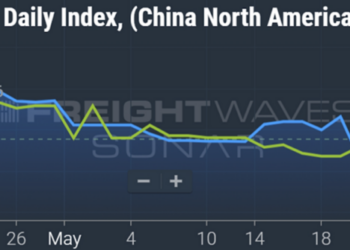The year 2020 marked a significant turning point for many businesses in the U.S. and throughout North America. First, the passage of the United States-Mexico-Canada Agreement went into effect, setting the stage for a more favorable trade environment. Then, businesses and consumers alike were abruptly confronted with the profound impact of supply chain disruptions caused by China’s Zero COVID Policy. These disruptions highlighted the fragility of global supply chains and underscored the need for more resilient trade strategies.
While the practice of nearshoring and reshoring manufacturing away from China has ebbed and flowed for many years, the incentive for companies to bring back more links in their supply chain to North America quickly is more apparent than ever.
However, the inherent value seen by many organizations in building out or expanding supply chains within North America has also led to challenges along the U.S.-Mexico border. Northbound over-the-road capacity has become a thorny issue for many U.S. and Canadian businesses that now incorporate (or are planning to) Mexican manufacturing and suppliers into their overall strategy.
“The capacity issue at the border has been going on for years,” said Ed Habe, Averitt vice president of Mexico sales. “Unfortunately, there is no indication that we will see a sudden turnaround anytime soon because many of these issues revolve around complex challenges, including transportation infrastructure, the driver and equipment shortage on both sides of the border, and also delays with inspections at crossing points.”
As nearshoring continues to gain momentum, shippers will increasingly face challenges with traditional over-the-road capacity from Mexico, leading to longer transit times and higher costs with securing limited space. According to Habe, organizations need to begin examining their transportation strategies sooner than later.
“Being the last to adapt in supply chain operations is a position no business wants to find itself in,” said Habe. “It’s crucial for companies, especially those dealing with high volumes or industries heavily reliant on speed-to-market, to proactively seek and implement effective methods for diversifying their transportation strategies out of Mexico.”
In terms of diversifying Mexico cross-border shipping operations, Habe suggests rail and even ocean moves via the Gulf could be potential opportunities under the right circumstances.
“Businesses should lock arms with their transportation partners and investigate whether or not there could be benefits in exploring non-traditional northbound moves,” said Habe. “Shipping across the Gulf rather than the border may sound a bit out of the box at first, but depending on the ultimate destination of the freight, some companies may achieve better efficiencies.”
Simultaneously, cross-border diversification extends beyond merely utilizing multiple modes of transportation. A key driver of capacity challenges is the preference of many shippers to use a limited supply of U.S. trailers for the entire journey from the origin in Mexico to the destination in the U.S. Consequently, this often leads to prolonged wait times for securing a U.S. trailer in Mexico, in addition to the delays experienced at the border.
One strategy shippers can employ to address this issue is transloading from a Mexican trailer to a U.S. trailer in a border town, such as Laredo or El Paso. This approach allows for quicker access to readily available Mexican trailers south of the border and ensures more reliable U.S. trailer resources on the stateside.
According to Habe, the best approaches to overcoming challenges with cross-border transportation today and into the future will always be strengthened by relationships.
“Shippers need to build partnerships with their transportation providers that go beyond just transactional needs,” said Habe. “The opportunities with nearshoring are exponential, but the risks for failing to strategize and diversify are just as great.”
Averitt has provided logistics solutions to, from, and within Mexico for over 25 years. Backed by a dedicated team of cross-border experts, customs brokers, and a strong infrastructure of distribution centers at the border, Averitt delivers door-to-door solutions that help simplify the complex nature of cross-border transportation.
The company’s recent white paper “Bypassing the Bottleneck: Solutions for Avoiding Freight Congestion at the U.S.-Mexico Border” further explores strategies shippers can use within their transportation strategy.
The post The Resilient Link: Strengthening U.S.-Mexico Supply Chains Through Diversification appeared first on FreightWaves.













